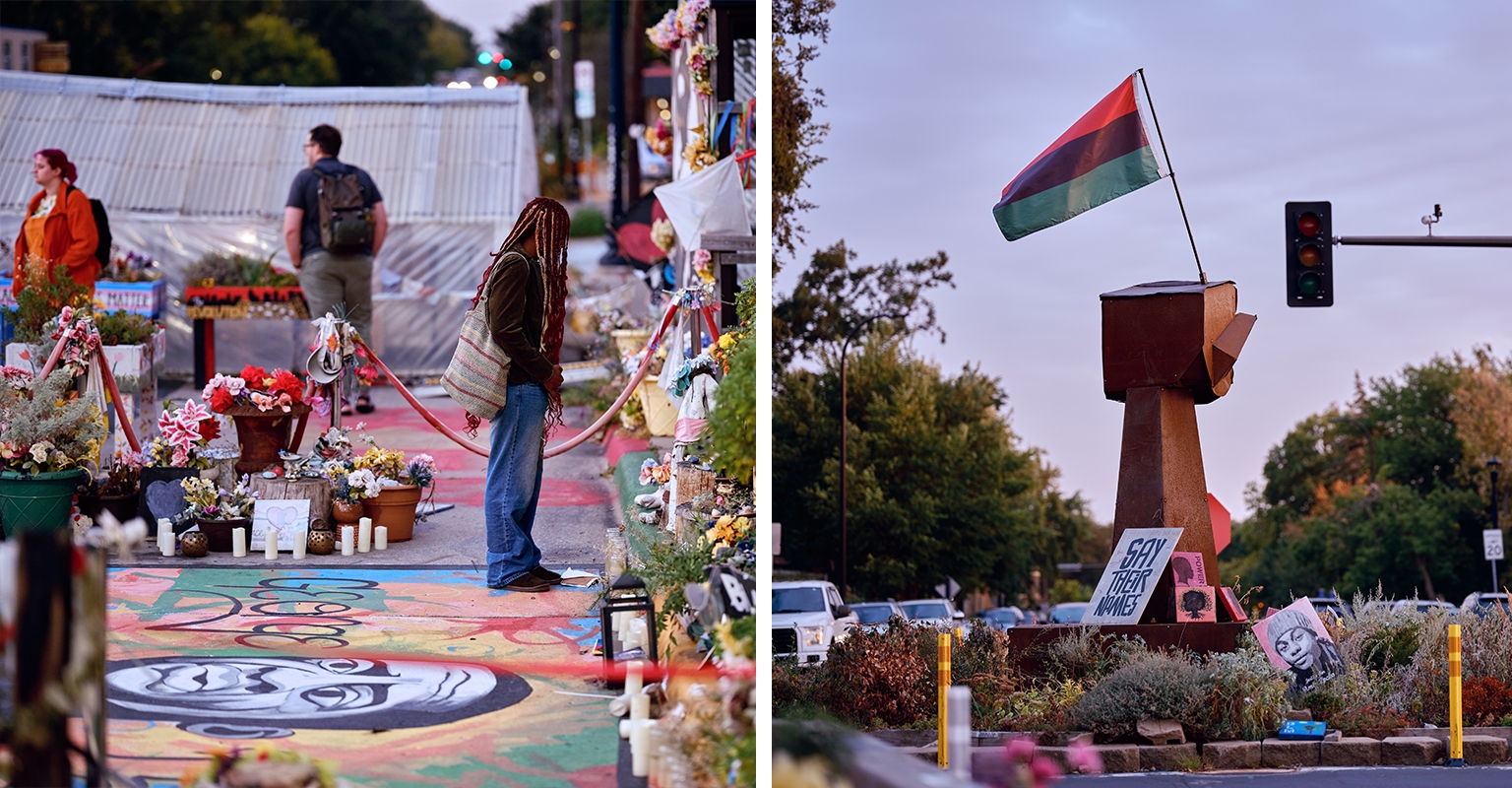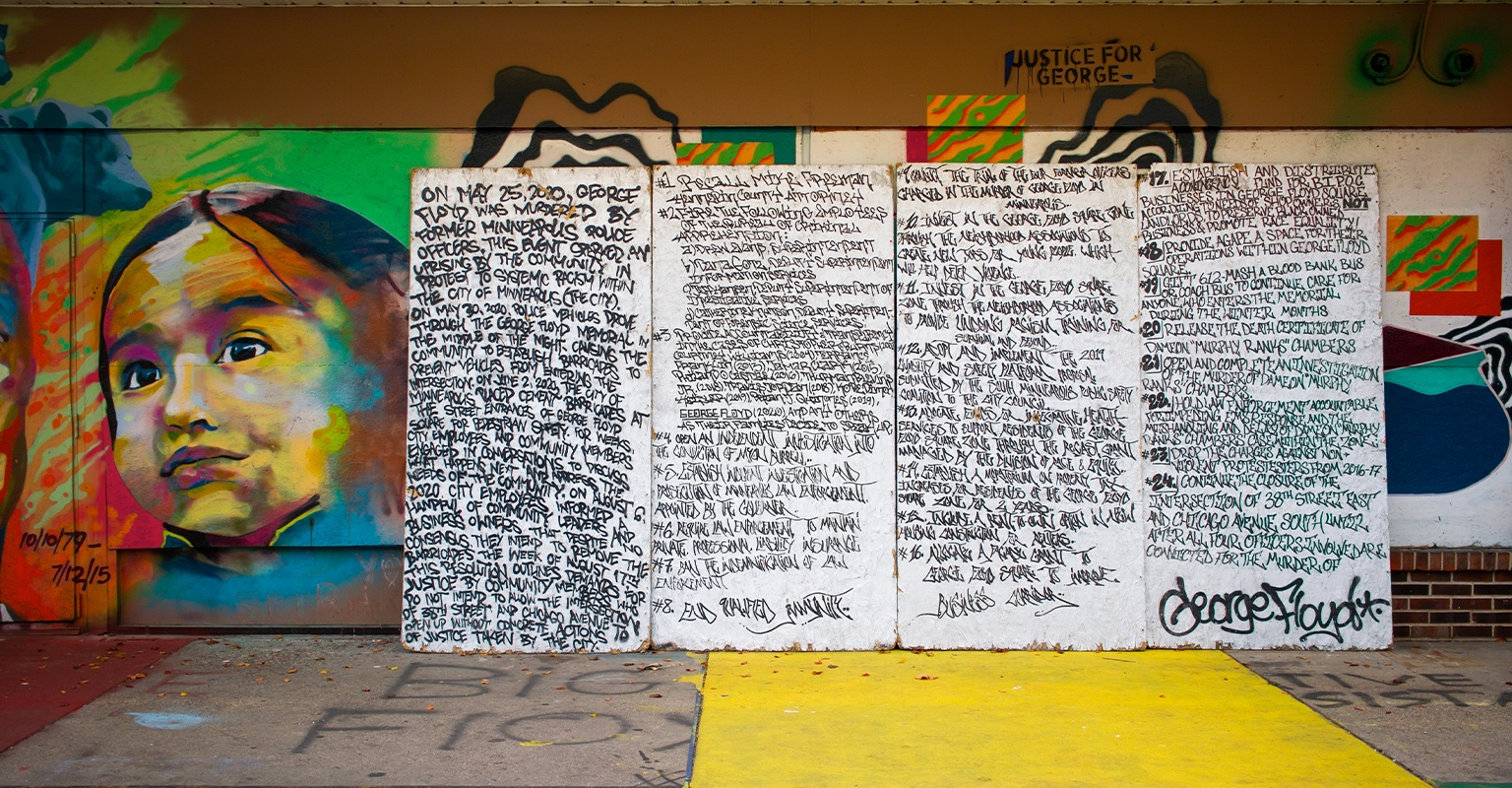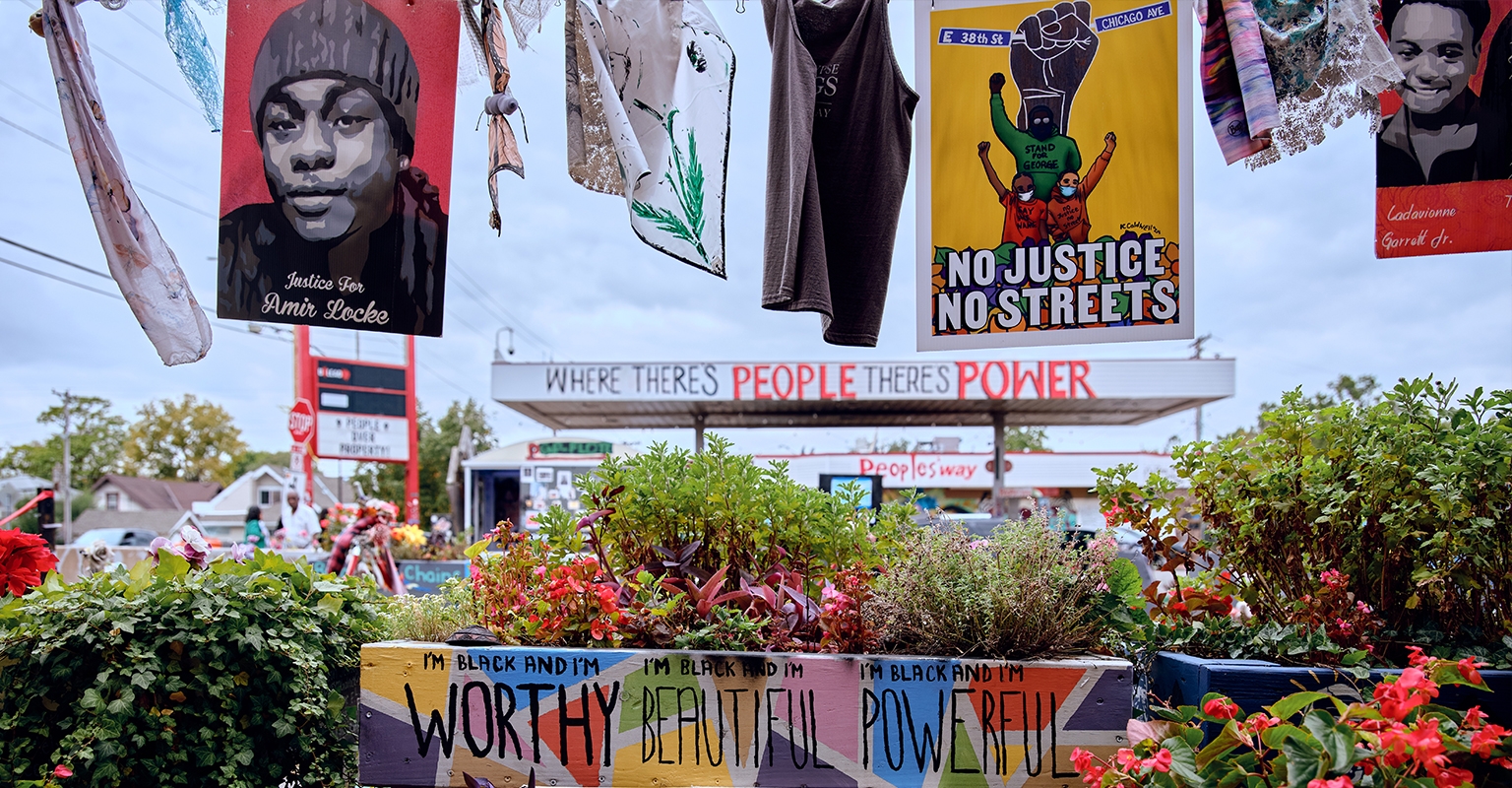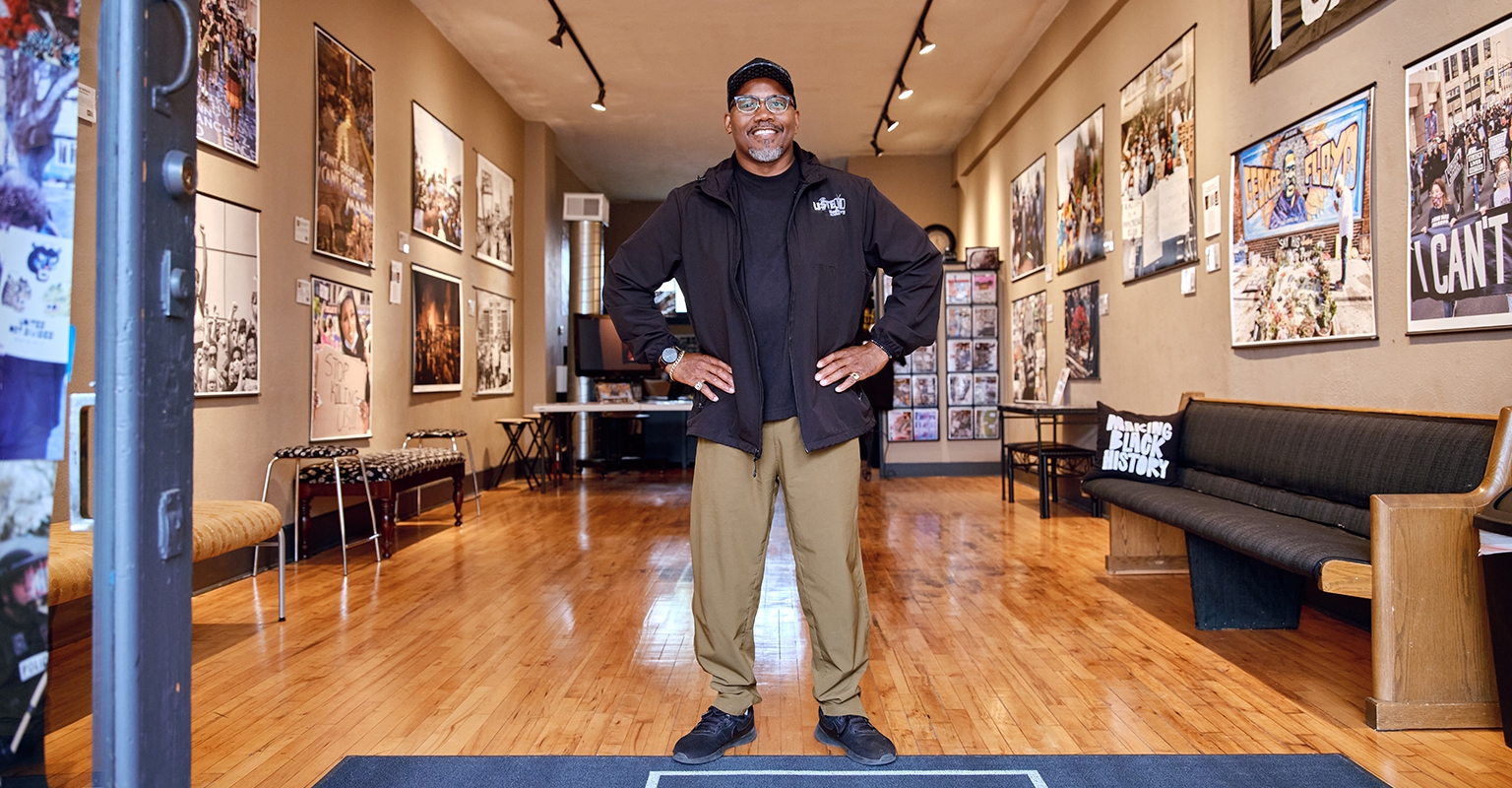Scenes from George Floyd Square
By Michael Kleber-Diggs
Two brown fists have been raised on Chicago Avenue in the area now known as George Floyd Square. Both are about 15 feet tall. There is a wooden one near East 37th Street, one block north of the spot where George Floyd was killed. It was made by a group of unknown artists and originally installed in the intersection at 38th and Chicago. In that intersection now, there is a steel version of the wooden sculpture. It was made by Jordan Powell Karis. It is meant to withstand weather and endure as a memorial.
The raised fists mark the northern and southern ends of George Floyd Square and serve as reminders to those who enter the space—simultaneously solemn and uplifting—of what happened here and the work toward a just world that remains undone. Since the evening when George Floyd was killed in May of 2020, this area has become many things—a place of protest and uprising, a gathering place, a place to serve community, a center for activism, a place for celebration, a tourist attraction, and a memorial, a grim reminder of the progress yet to be made against racism and institutional violence.

People Come from All Over
I visited on a pleasant weekend near the end of a summer of drought. I parked near the Baha’i Center of Minneapolis and entered the square from the north. I was there near midday, and 50 or so people were there at the same time—honoring George Floyd, taking photos, or talking to Charles McMillian, a witness to George Floyd’s murder who rose to prominence for his testimony at trial. I heard him tell a Black family—two parents and three children—where he was standing when he spoke to George Floyd, when he told him “you can’t win.”
Most people seemed grave and introspective as they explored the features of the square. People come from all over the world to visit the site or include it as part of their visit to the Twin Cities. While I walked around, I heard visitors from the Netherlands speaking Dutch, and I talked to a Black grandmother from Milwaukee named Tischa Brown. She came to Minneapolis specifically to see George Floyd Square and spoke to me of the challenges of honoring life and death at the same time in the same place.
As you enter the space from the north, you’ll see, painted on the street in white text atop black panels, the 24 protester demands that were presented to the city in August of 2020, demands people wanted to see met before the street was reopened to vehicular traffic.

Just beyond those, in large colorful, carefully painted capital letters are the names of several people who have lost their lives to police violence. That list of names runs the length of the block. George Floyd is centered in everything that’s happening at the square named in his honor, and, at the same time, the area is in memoriam to others who lost their lives, a reminder that what happened to George Floyd was part of a larger epidemic of unnecessary and lethal police violence.
Fists and Flowers
There are many community-oriented features at George Floyd Square. There is a clothing shelf installed in two former bus stop shelters, just a few steps west of Chicago Avenue on East 38th Street. People often make food available in the parking lot of what was once the Speedway mini-mart (now called People’s Way). On the day I visited, The Sanneh Foundation was giving away chicken enchiladas. There are gardens—flower gardens and vegetable gardens, and there is an area that seemed intended as a space to give away perennials. There is an information kiosk in the parking lot of People’s Way, and, across the street, a greenhouse including a scruffy couch, and several potted flowers and vegetable plants.
George Floyd Square includes a lot of art as well. In addition to the raised fists, there is the “I Can Breathe Now” mural along the south side of Cup Foods made by Cadex Herrera, Greta McLain, and Xena Goldman, and “George Floyd at Memorial Site'' by Peyton Scott Russell. Just north of the memorial site, there is the “You Changed the World, George” mural attributed to several artists. There are prayer flags with hand-written messages from many different people, and there are dozens of paintings, posters, and signs, handmade and not, throughout the square. Many were made to honor George Floyd, others were added to call attention to other lives lost—Philando Castile, Breonna Taylor, Daunte Wright.

Then, there is the memorial itself—a cordoned off space in front of Cup Foods. Whenever I’ve visited, people have lined up just outside that space to take turns entering. The area is usually surrounded by flowers, some fresh, some faded. Art is abundant in this space, too. On the street where George Floyd was killed, an unknown artist painted an angel in blue and white on the street. The angel has wings and beams of light surrounding his head; below his feet “I can’t breathe” appears twice. There are often candles there and a few empty bottles of Remy Martin and Hennessy. The prayer flags are draped there.
Say Their Names and Listen 2 Us:
During your visit, make sure to see the “Say Their Names Cemetery,” one block north and one block west of George Floyd Square at 37th and Columbus. It was made by Anna Barber and Connor Wright and includes tombstones with the names of 132 people of color who have been killed by police.
Around George Floyd Square, there are businesses that are worth your attention. Some visitors may want to enter Unity Foods, the former Cup Foods business George Floyd entered just before he was killed. On the west side of the street is Listen 2 Us art gallery and media studio founded by internationally recognized photojournalist and activist, KingDemetrius Pendleton, who focuses on "documenting our history for posterity". Smoke in the Pit is a highly rated Black-owned barbecue restaurant on the east side of the street.

The site will always be a place to remember George Floyd—his inhumane death, and the uprising his loss inspired. As you navigate the square, whether you’re viewing art, visiting with witnesses, activists and artists, donating clothes, getting a free meal, or planting flowers, George Floyd is ever-present. The memory of him and of what happened to him is palpable and raw. It pulls visitors back in time to the day he died, and forward toward the possibility of a more just future.


